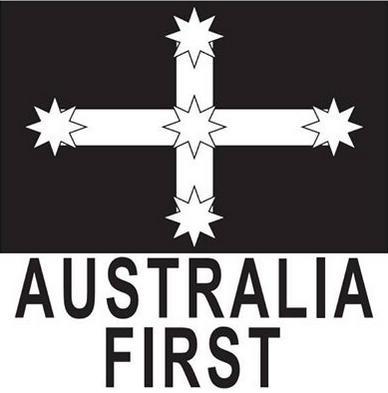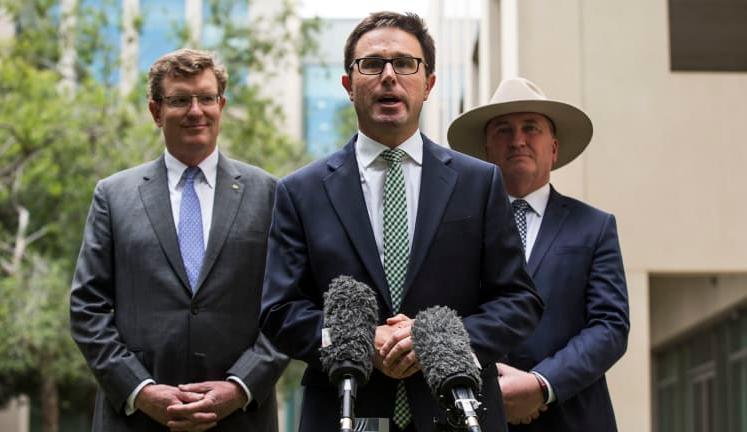Australia’s legendary Darling River of 1400+km long has been drained and poisoned upstream by the greedy invasive Chinese. Chinese owned Cubby Station outside Dirranbandi in south-west Queensland is some 33,000 hectares of desert-bound saltbush and Mulga.
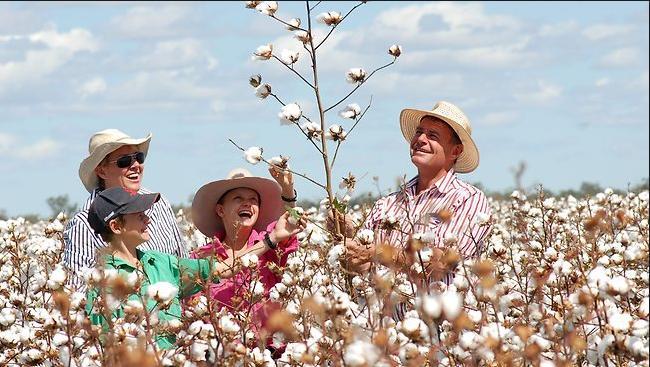
Cotton artificially grows here on synthetic fertilizer steroids and by stealing water from the Darling River in outback Queensland
Winners are grinners, especially when they sellout their Australian acreage to the Chinese for $240 million, thanks very much.
History of Cotton Greed and Failure
Cubby Station is situated in south-west Queensland just south of remote Dirranbandi.on the Lower Balonne Floodplain within the Condamine–Balonne rivers catchment. It vitally forms the headwaters of Australia’s massive Murray–Darling Basin. The rivers start from the Darling Downs and meander their way south-west into New South Wales, ultimately flowing all the way to the mouth of the Murray River south of Adelaide. The topography of the area is defined by channels & floodplains of the upper reaches of the Darling and Barwon Rivers. The alluvial floodplain is very ephemeral, often dry, and tending to flood every decade or so between droughts, such as has been Australia’s outback climate pattern for millennia.
For over a century the region the Lower Balonne Floodplain was used for sheep and cattle grazing. Cubby Station was a cattle grazing property until earthmoving contractor Des Stevenson bought it in 1983. He proceeded to re-landscape it and dam build to irrigate the alluvial flood plain between the river systems of the Culgoa and the Balonne Minor for exotic deep-rooted cotton. He reckoned cotton would grow to exploit the deep black clay soils which have high moisture-holding capacity . Former public servant with Queensland’s Water Resources Commission, John Grabbe, went to work for Stevenson to convert Cubbie Station into what is now Australia’s largest privately owned irrigation layout. Neighbouring graziers like Reg Betts argue that Cubbie and other water harvesters have done such a comprehensive job bull dozing and dam building in the Lower Balonne they’ve irrevocably changed the floodplain.
Bit by bit Cubbie raised its levee banks and has grown into an aggregation of twelve adjoining properties to give Cubbie a total of fifty-one licences thirty-five kilometres long, fed by water from storage dams capable of holding 440,000 mega litres. Also Cubbie’s water rights include some 51 licences to extract water during floods, which can average 100,000 mega litres annually.
In 2005, Cubbie Station merged with Blache Cotton and corporatised as Cubbie Group Limited under the chairmanship of former Queensland Labor Treasurer Keith De Lacy to become the biggest cotton producer in Australia.
But in 2009 the exotic crop naturally failed in the outback due to drought. Cubbie Group Limited went into voluntarily administration with debts of $300 million. By 2012, the Foreign Investment Review Board approved the sell-off to the Chinese and Japanese for 100% cotton export back to China.
Export Cotton sucking the Darling River Dry
Cotton is a very thirsty crop, not as water-intensive as rice, but it’s amongst the worst. Cubby Station’s water storage dams stretch for more than 28 km along the Culgoa River, within the Murray-Darling basin. In an average year the station uses 200,000 megalitres of water, in a good year as much as 500,000 megalitres – so robbing the downstream Darling River.
Some say Des Stevenson the grader driver, bought Cubby not for the cotton, but just so he could play by himself out in the Mulga in the biggest dirt pit in Australia.
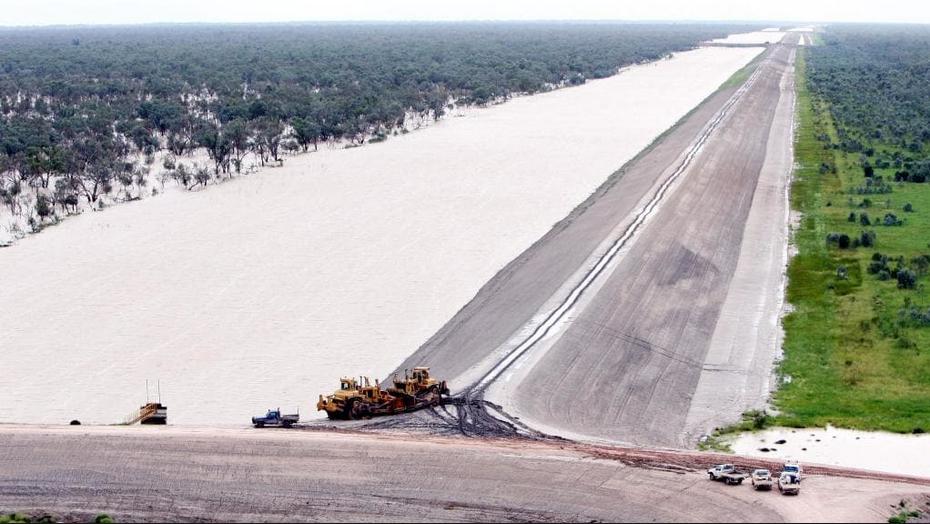 Illegal diversion channels, 100% man-made at artifically water exotic cotton
Illegal diversion channels, 100% man-made at artifically water exotic cotton
The water is used to supply 130 square kilometres of irrigated cotton and other crops including wheat, which generates a net profit in the range of A$50 million to A$80 million a year (all exported to China).
The station is licensed to take 460,000 megalitres, which is the equivalent of all irrigation entitlements downstream in north-western NSW. The property has the capacity to grow 200 square kilometres of cotton.
Some say Des Stevenson chose cotton so get could do crop circles, and other weird patterns.
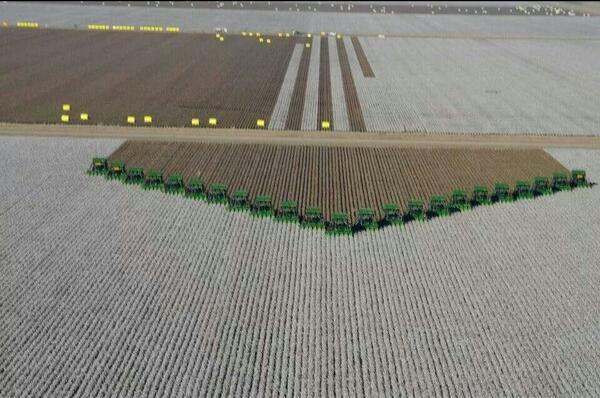
Greedy multinationals are continuing to prop up unsustainable cotton farming wholly dependent on fake high rainfalls and fake rich nitrogen soils which don’t exist out in the Outback. Cubby Station’s cotton farm is the largest water allocation abuse (theft) in Australian agricultural history. It’s because of a cosy corrupt deal with National Party funding.
Canberra approved damning the Darling River and Menindee Lakes to supply tropical water irrigation artificially.

In doing so, Canberran insular and overpaid boffins have denied vital drinking water to downstream Broken Hill with a population of some 17,000 Aussies, who are now in crisis. So thousands of locals are selling up and leaving.
Canberra has allowed the Chinese to contaminate the Darling River flood plains with synthetic β-Methylamino-L-alanine (BMAA) fertilizer for aggressively and artificially cotton growing in the desert. The entire crop is for export to China of course.
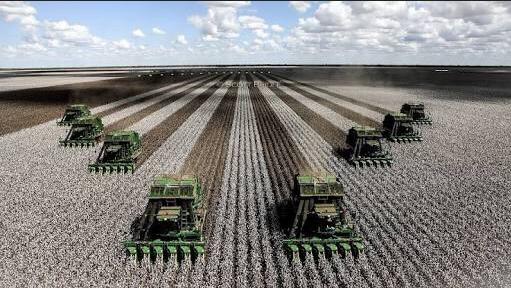
Abuse of Australian land or what?
BMAA is a known neurotoxin which means it is poisonous or destructive to nerve tissue. Two samples containing BMAA have been collected from the Murrumbidgee River, which runs through the NSW Riverina, a hotspot for motor neurone disease in Australia. BMAA also has suspected causal links to neurodegenerative diseases such as Parkinson’s disease, Alzheimer’s disease and Amyotrophic lateral sclerosis. Positive samples have also been collected in Centennial Park and Botany wetlands in central Sydney, as well as Manly Dam on Sydney’s Northern Beaches.
A Million Poisoned River Fish
Last week it has been reported from outback New South Wales that a million Murray Cod (some up to 100 years old) have been poisoned by fertilizer-fed algal bloom. Australia’s iconic Murray Cod and big fresh water fish and critically endangered.
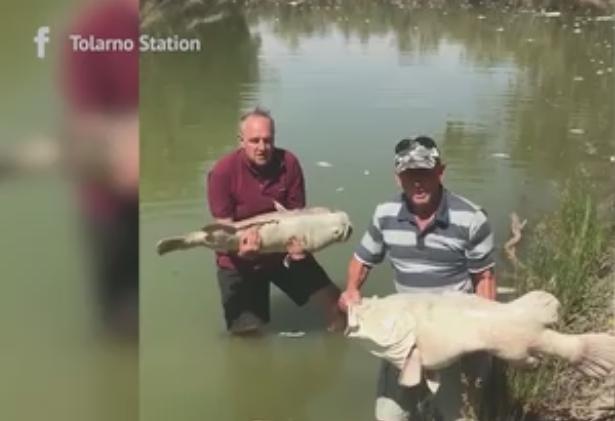
Local farmers of Tolarno Station reveal mass poisoning of Murray Cod in the blue-green Darling River
Last month, Menindee local Wayne Marsden went to check his water pump and discovered hundreds of dead fish floating in putrid water of Darling River. On December 20, a NSW District Fisheries officer confirmed that an estimated 10,000 river fish had been mass poisoned by a widespread blue-green algae bloom along a 50-kilometre stretch of the river.
Now that figure is around a million.
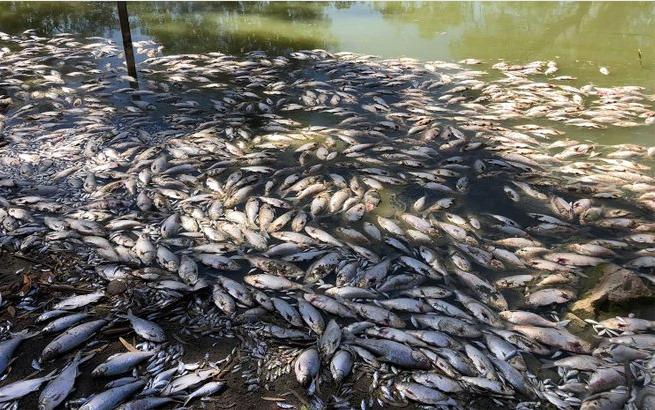
The blue-green algae bloom has manifested due to excess nutrients in the water, particularly phosphorus and nitrogen. The algae spreads across the water surface denying dissolved oxygen to the water below essential to aquatic life. The algae also produced toxins called cyanobacteria which smell like rotting plants. It basically poisons all aquatic life such as fish. In this case Bony Bream, Golden Perch, Silver Perch and the mightly but threatened Murray Cod were the native species mainly affected.
CSIRO environmental scientist Dr Tim Malthus has said that the blue-green algae in such high concentrations have been driven by a build-up of nutrients from agricultural run-off combined with weirs extracting the natural river flows for irrigation causing stagnant water pooling, plus the drought reducing tributary inflows and the high temperatures this time of year. The latter two factors are natural, but the key causes, agricultural run-off and the weirs, are man-made and have killed the Darling.
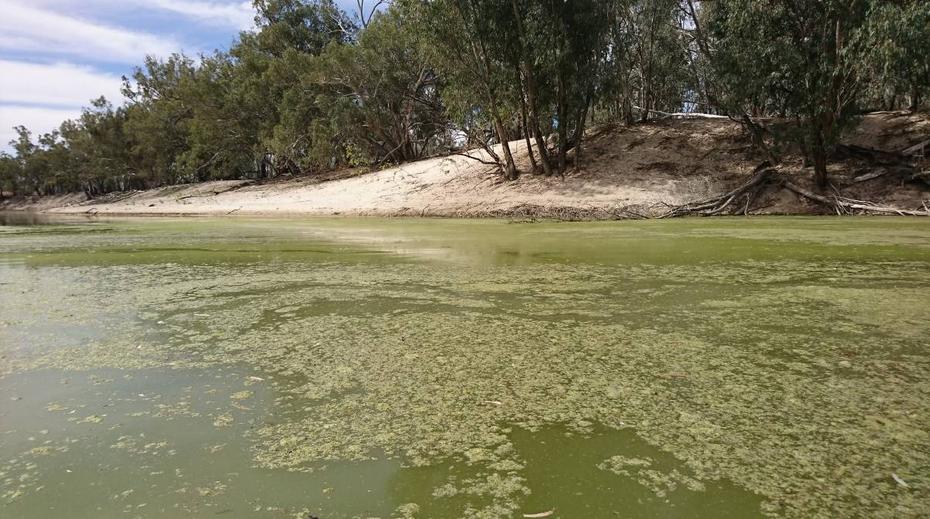
overnments are accused of mismanaging the Darling River to benefit cotton growers and those upstream.
Some towns, like Menindee, are down to 3% dam capacity and have already been carting water as the river supply became unfit for human consumption. Swimming in water affected by blue-green algae can also cause skin irritations and gastroenteritis.
The lower Darling River is in so much trouble that a 270-kilometre pipeline is being built to supply Murray River water to Broken Hill, which used to supplement its water supply from the Darling River via the Menindee Lakes.
The new pipeline is needed because the Menindee-to-Broken Hill pipeline, which has been used for the last 65 years, can no longer access a reliable source of water from the Darling. Despite a dramatic fall in the population of Broken Hill since the 1970s, there is no longer enough water flowing down the Lower Darling River into the Menindee storage because of the increased water use upstream.
Niall Blair MP is Gladys Berejiklian’s Fisheries and Regional Water Minister, but his only practical experience outside the public service is in tree pruning – starting off at Sydney’s inner-west leftie Marrickville Council then on to Leeton Council.
Blair deflects blame reckoning that decisions to release water from the Menindee Lakes over many years were not the sole responsibility of New South Wales Government water management, but that the actual problem was a lack of replenishment due to drought, aka da ‘Climate Change’ default excuse.
Blair:
“The issue is we haven’t had any water coming down the system to replenish those lakes. Evaporation does play a large role as well.”
So evaporation has slaughtered all the Murray Cod?
Pull the other one. Blair’s not just wrong, he’s an arse protecting liar.
Blair acknowledged he did not meet a group of about 150 people gathered at a boat ramp on Wednesday (many of whom had travelled for hundreds of kilometres to be there), but said this was due to security concerns after supposed threats were made. He spoke with other locals along the river bank, and met with local councillors.
Rural Australians just have such high regard for Nationals MPs. Nationals like Andrew Broad reciprocate out of Hong Kong brothels.
And as federal Agricultural Minister Barney Joyce turned a blind eye to water theft by irrigators.
Trust the Gnats to look after their multinational donor mates.
Cotton Fertilizer to Blame
At upstream Chinese cotton Cubby Station, cotton consumes Nitrogen (N) at a double quantity compared to Phosphorus (P) and Potassium (K).
While the deep black clay soils of the region are ideal for cotton with its metre long vertical roots, the native soil is poor in nutrients. So massive quantities of high nitrogen fertiliser have been applied by the hundreds of tonnes. Typical fertilization scheduling applies 200 kg of N-P-K 20-10-10 per hectare during sowing, plus a further 200 kg of N-P-K 20-10-10 per hectare during flowering (early summer). Add to this the typical cotton fertilizer need for 250 kg of ammonium nitrate.
And it runs off into the river system. That’s why now in mid summer all the downstream Murray Cod in the Darling River have been poisoned.

Then there’s all the herbicide, insecticide and fungicide applied which inevitably drifts in the wind. On Christmas Day 2017, Cotton Australia, peak body for Australia’s cotton growing industry, reported that 6,000 hectares of young cotton had been damaged by spray drift up to 70km away from application of phenoxy herbicide (a systemic weed killer). Phenoxy includes dioxin and is linked to causing Hodgkin’s lymphoma (a blood cancer) and sarcoma (a soft-tissue cancer).
Thene there’s the increased salinity from the irrigation. So cotton is a very bad crop. It’s a crop traditionally grown in the coastal Indus Delta in north-west India in a floodplain region which receives up to 500mm of rainfall a year. But the Indus delta has died from centuries of dams and barrages that have been built higher up on the Indus River.
Cubby Station gets around 420mm in a good year, but they can be a decade apart, between droughts. So it’s a dumb extreme crop for the region, like the Chinese currently trying to grow potatoes on the far side of the moon.
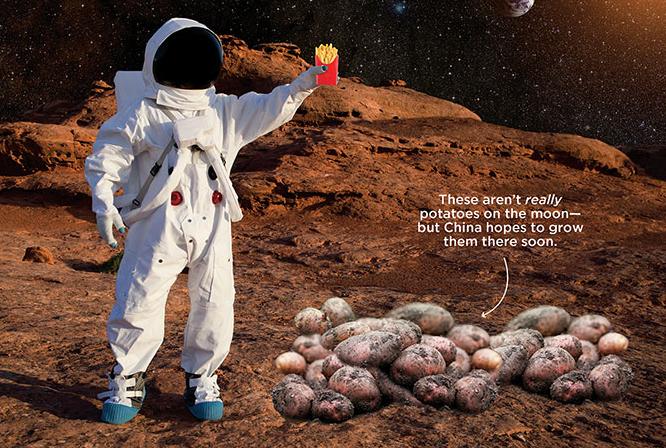
Cubby Sale to the Chinese
It was of course Gillard Labor’s August 31 of 2012 approved foreign sale of the Cubby Station upon corrupt advice from the Foreign Investment Review Board to Shandong RuYi Scientific & Technological Group Co Ltd, headquartered in Jining, Shandong Province, China.
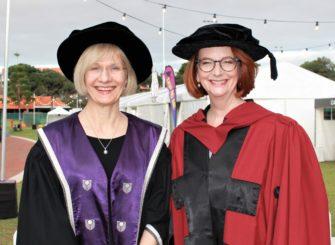
Gillard has a legacy of under-achievement but many assorted frocks
In the past 30 years, Australian rivers have had the dubious honour of hosting some of the largest algal blooms in history. In 1991 a bloom stretched along more than 1,200km of the Darling River, prompting the New South Wales government to declare a state of emergency. The army was mobilised to provide aid to towns. Since then, south-eastern Australia has had four large blooms, most recently in 2016. The future isn’t promising either. Rising water temperatures mean blooms are likely to increase in frequency and duration in the future.
Multinational farms like Cubby have also been greedily extracting too much water upstream so there is not enough for downstream users, and the fish.
Another Queensland cotton farmer near Goondiwindi, John Norman, last August was charged with defrauding the Commonwealth of $20 million by making fraudulent water efficiency claims under the Murray-Darling Basic Plan between 2010 and 2017.
Local farmer downstream 40km south of Menindee, Rob McBride says:
“This has nothing to do with drought. This is a man-made disaster brought to you by the NSW government, the federal government and the Murray-Darling (Basin) Authority.”
Murray Darling Basin Plan a catalyst for dispossession by multinational mates of the Nationals
by Dr Jim Saleam
‘The National Party have been absolutely aware of the water problems but chose to ignore the problem. It’s no accident. These areas without water will become mass mining dumps and multinational agriculture adventures. Liberal lapdog Nationals Deputy Prime Minister Michael McCormack had to rush through his friends inland rail big business (big money for those in the know) project a few weeks ago before the magnitude of the water problems became a matter of public record.
So much for the voice of the bush (just like Andrew Broad more interested in his seat in Hong Kong).
It takes public outrage after long-suffering and long being ignored by the National Party to get some attention to what is a humanitarian crisis unfolding and an ethnic cleansing of certain areas pre the National Party’s mining mates moving in to these areas.
Traitors and Thieves.
In the final analysis both LIB/NAT and LABOR/GREENS are entirely responsible for this Treachery.’
Vote 1 Dr Jim Saleam for Cootamundra – For An Ideological Revolution.
